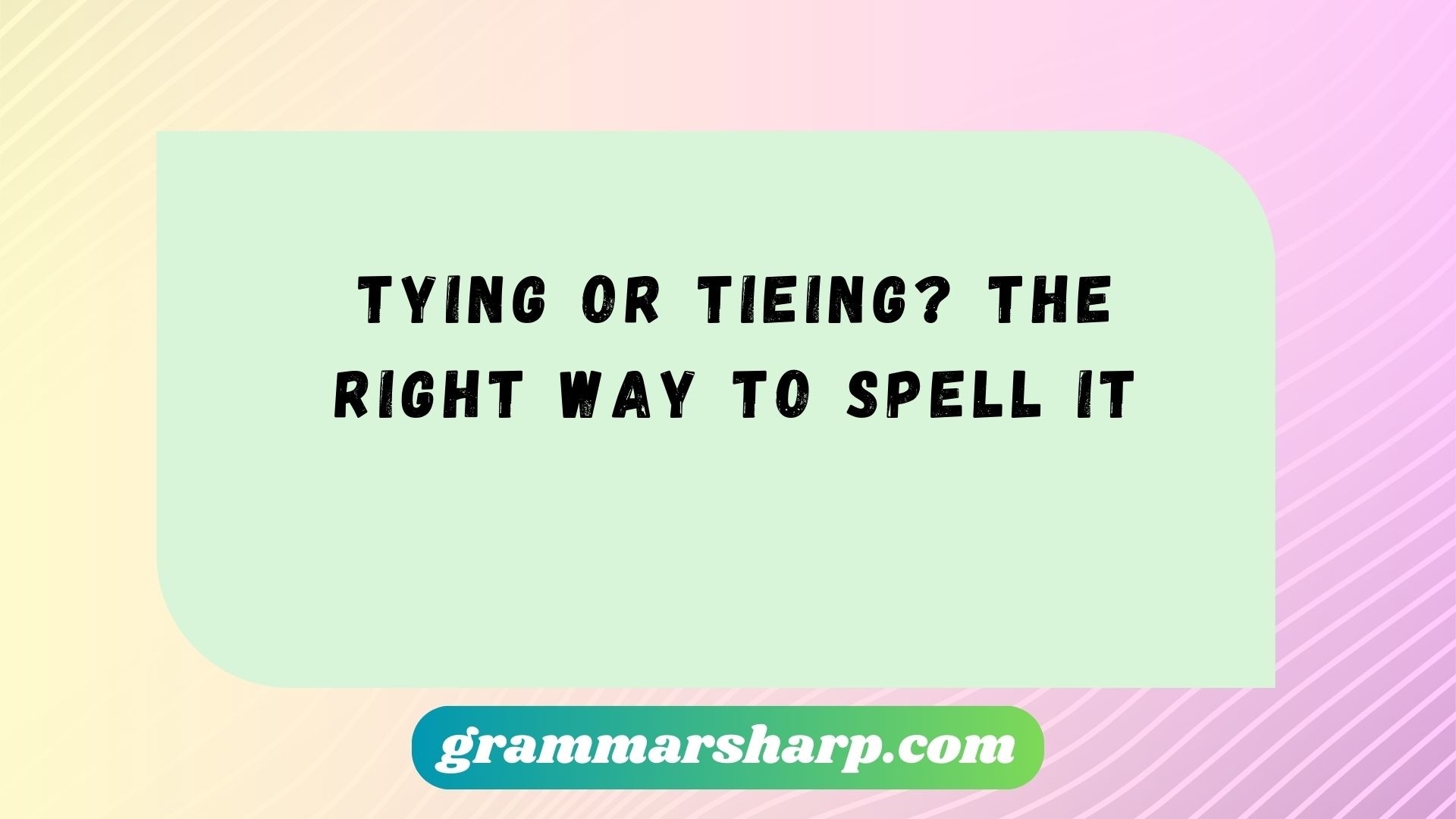English spelling rules can feel like a puzzle. Sometimes they’re simple, and other times they twist in ways that make even confident writers pause. One of the most common head-scratchers people face is whether the correct form is tying or tieing. At first glance, tieing might look perfectly reasonable—you take the word tie and add -ing. But is that really the right way?
This question pops up more often than you’d expect. From school essays to professional emails, small spelling choices like this can change the perception of your writing. Employers, teachers, and readers often notice spelling accuracy before they notice content. So, knowing the correct form matters.
The answer is clear: tying is the correct spelling in standard English. Tieing might feel intuitive, but it isn’t accepted in dictionaries, academic writing, or professional style guides. This blog post explores the differences, grammar rules, common mistakes, historical background, and practical tips to make sure you never hesitate again.
By the end, you’ll not only know why tying is correct but also understand the rules behind it, recognize similar spelling patterns, and walk away with memory tricks to avoid future confusion. Let’s unravel the knot around tying vs. tieing.
Tying vs. Tieing: The Correct Spelling
The correct spelling is tying.
- Tying means fastening or securing something with a knot or bond.
- Tieing is not a recognized word in modern English dictionaries.
For example:
- Correct: She is tying her shoelaces before the race.
- Incorrect: She is tieing her shoelaces before the race.
Both may look reasonable, but only one is backed by grammar rules and dictionary standards.
According to Merriam-Webster, tying is the present participle of tie, while tieing does not appear as a valid entry. The Oxford English Dictionary and Cambridge Dictionary confirm the same.
The Grammar Behind the Word

To understand why tying is correct, you need to look at English spelling rules.
When a verb ends in -e, you usually drop the e before adding -ing:
- bake → baking
- move → moving
- write → writing
The word tie follows this rule. Drop the e and add -ing:
- tie → tying
This rule exists to prevent awkward letter combinations. If you kept the e, you’d end up with tieing, which would look clumsy and break standard spelling patterns.
Another example is die → dying and lie → lying. Notice how these words not only drop the e but also adjust the spelling slightly because of the ie → y change.
Common Mistakes Writers Make
People often spell the word as tieing for several reasons:
- Logical extension: Since the root word is tie, adding -ing feels straightforward.
- Non-native English learners: Many second-language learners rely on phonetic spelling, so tieing feels more natural.
- Spellcheck limitations: Early versions of word processors sometimes didn’t flag tieing as incorrect, leaving people unsure.
- Typing errors: Quick writing can lead to accidentally adding an unnecessary e.
However, once you know the rule about dropping the e before adding -ing, it becomes second nature.
Examples in Everyday Use
The word tying shows up in daily conversations, literature, and professional writing. Here are a few common uses:
- She is tying a ribbon around the gift.
- They are tying up loose ends before launching the project.
- He is tying the fishing line with precision.
- The match ended with both teams tying the score.
Incorrect uses with tieing:
- She is tieing a knot for the boat. (❌)
- He kept tieing his shoes over and over. (❌)
Table: Correct vs. Incorrect Examples
| Correct Use | Incorrect Use |
| She is tying her shoelaces. | She is tieing her shoelaces. |
| They are tying up loose ends. | They are tieing up loose ends. |
| He kept tying knots all afternoon. | He kept tieing knots all afternoon. |
| The teams are tying for first place. | The teams are tieing for first place. |
Historical Background

Was tieing ever considered correct? Interestingly, yes—though briefly.
In older forms of English, especially during the 17th and 18th centuries, some writers experimented with spellings like tieing. However, dictionaries from the 19th century onward standardized tying as the correct form.
For example:
- Early print texts occasionally used tieing, but it never became mainstream.
- Samuel Johnson’s famous 1755 dictionary listed tying, setting the standard for future usage.
So, while you may stumble across tieing in rare historical documents, it’s considered outdated and incorrect today.
Exceptions and Related Words
English is full of exceptions, and the ie → y pattern plays a big role here.
- tie → tying
- die → dying
- lie → lying
Notice that in these cases, the ie changes to y before adding -ing. This avoids awkward clusters of vowels that make words harder to read or pronounce.
However, not all -ie words behave this way:
- pie → pieing (rare but sometimes used in baking contexts)
- vie → vying
This creates confusion, but dictionaries clearly define the acceptable versions.
Memory Tricks to Remember the Right Spelling
Here are some simple ways to remember:
- Rule reminder: Drop the e before adding -ing.
- Think of crying/trying: Words like trying follow the same pattern as tying.
- Visual mnemonic: Imagine tying a knot—the knot hides the “e.”
Quick tip: If you ever doubt yourself, plug the word into a reliable dictionary or use a grammar tool.
How Dictionaries and Style Guides Treat It
Every major authority agrees: tying is correct.
- Merriam-Webster: Defines tying as “the act of fastening or securing by means of a tie.”
- Oxford English Dictionary: Recognizes tying as the present participle of tie.
- Cambridge Dictionary: Lists tying with multiple usage examples.
Professional writing style guides like the AP Stylebook and Chicago Manual of Style also confirm tying as the accepted form.
Practical Writing Tips
Want to avoid spelling errors like this in your own writing? Try these tips:
- Use digital tools wisely: Grammarly, Microsoft Word, and Google Docs flag tieing as incorrect.
- Proofread carefully: Don’t rely solely on spellcheck. Reading aloud helps catch mistakes.
- Study common word patterns: Familiarize yourself with rules like dropping e before -ing.
- Build a personal word list: Keep track of words you frequently misspell.
FAQs
Is tieing ever acceptable?
No, modern dictionaries and style guides reject tieing.
Is there a British vs. American difference?
No, both UK and US English use tying.
Why does English drop the “e”?
Dropping the e prevents awkward letter combinations and follows a consistent spelling rule.
Are there other confusing words like this?
Yes—dying, lying, vying, and pieing are similar cases.
Does anyone still use tieing?
You might see it in rare historical texts, but it’s incorrect today.
Conclusion
The correct spelling is always tying, never tieing. While the mistake is understandable, knowing the grammar rule makes it easy to avoid. Remember: drop the e before adding -ing.
Small details like this might seem minor, but they add up. Correct spelling shows attention to detail, boosts credibility, and keeps your writing polished. Next time you’re writing about tying shoelaces, tying knots, or tying up loose ends, you’ll know with confidence that you’ve got it right.
Mastering tricky spellings isn’t about memorizing endless rules—it’s about learning patterns that apply again and again. Once you learn tying, you’ll unlock similar words and boost your overall command of English.

